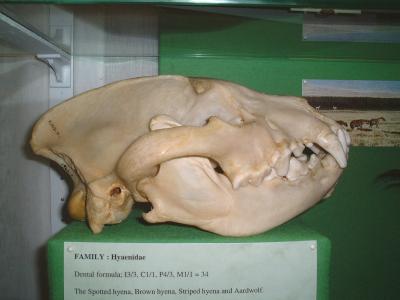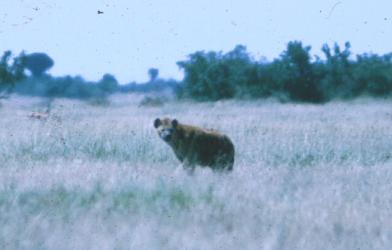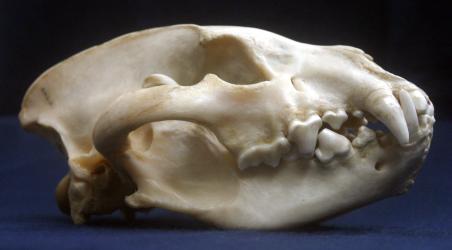

ORDER CARNIVORA
FAMILY HYAENIDAE
HYAENA FAMILY
General features and members of the hyaena family
The hyaena family is one of the four families of terrestrial cat-like mammals descended from the Viverraines (civet/genet like mammals); the earliest hyaenids emerged over 25 mya in Africa or Asia.
 |
| Picture of spotted hyaena in the open grassland of the Serengeti showing the characteristic features of the hyaenid. |
Hyaenids are long-legged long-necked carnivores with large eyes and ears and a blunt muzzle. They have a shaggy striped or spotted coat and a short hairy tail. The feet are large with five heavily padded toes. Their shoulders are higher than their hindquarters.
There are four species: Spotted hyaena (Crocuta crocuta), Brown hyaena (Hyaenea brunnea), Striped hyaena (Hyaena hyaena) and Aardwolf (Proteles cristata). The Ardwolf is the smallest (0.85 - 1.0 m long; 8-12 kg); the Spotted hyaena is the largest (1.2 - 1.40 m long; 50/80 kg). Aardwolves look like minature Striped hyaenas; they feed on insects and apparently diverged from other hyaenas some 15 - 32 mya.
Hyaenids occur in Africa, the Middle East and India. The Striped hyaena is the most widespread ranging from North Africa through the Middle East to India. The Spotted hyaena inhabits fringes of tropical rain forest, deserts and savanna of Sub-saharan Africa. The Brown hyaena is found in arid regions of Southern Africa. Striped, Spotted and Brown hyaena all live in clans. Spotted hyaenas communicate with each other by sounds - some of which are audible to humans, others are not. Among the sounds that are particularly suited to long-range communication and that humans can hear are whoops and the particular cackles, which give the Spotted hyaena its alternative name of Laughing Hyaena. The two subspecies of aardwolf inhabit open grassy plains of East Africa (P. cristatus) and South Africa (P. septentrionalis).
Diets and life styles
Strong jaws, strong teeth, a very efficient digestive system and the ability to cover large distances at night make hyaenas the most efficient mammalian scavengers. Brown and Striped hyaenas feed mainly on carrion supplemented with insects, fruits and small prey animals. Very little of the Brown hyaena’s diet is made up of food it has killed itself.
The Spotted hyaena not only scavenges for carrion but is an efficient hunter running down its prey at speeds of up to 60km/h and over distances of 3 km. Spotted hyaenas mainly prey on the young of large antelope but can pull down larger animals such as zebra. In contrast, the aardwolf forages for harvester termites and insect larvae.
Skulls, dentition and diet
The skulls of hyaenids are robust and long. All members have the complete dental formula of I3/3; C1/1; PM 4/3; M1/1 = 34 (among carnivores only members of the cat family have less) although adult aardwolves may loose their cheek teeth and be left with as few as 24 teeth.
 |
| Striped hyaena skull (Dental formula: I3/3; C1/1; PM 4/3; M1/1 = 34). The massive skulls of the hyaenas have relatively short jaws which give a powerful grip. The molars of the Striped hyaena (Hyaena hyaena) and Brown hyaena (Hyaena brunnea) are relatively small and the carnassials do the crushing shearing and slicing. These features are due to these two species feeding on a wide range of food: insects, eggs, wild fruit as well as carrion and small prey. In contrast, the skull of the Spotted hyaena (Crocuta crocuta) is specialised for crushing bones and cutting hides which other large carnivores are unable to consume and digest. The bone crushing premolars are relatively large and the carnassial teeth are used solely for slicing or shearing. |
| Dog-like carnivorans | Aquatic carnivorans | Cat-like carnivorans |
|---|---|---|
|
|
|






